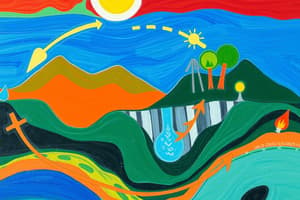Podcast
Questions and Answers
What is meant by the term 'pool' in the context of carbon cycling?
What is meant by the term 'pool' in the context of carbon cycling?
- A balance between carbon sources and sinks.
- A type of carbon flux.
- A method of carbon storage. (correct)
- A mechanism for carbon release.
Which process primarily contributes to carbon being a net sink in ecosystems?
Which process primarily contributes to carbon being a net sink in ecosystems?
- Decomposition
- Respiration
- Photosynthesis (correct)
- Combustion
During which process is carbon primarily released back into the atmosphere?
During which process is carbon primarily released back into the atmosphere?
- Photosynthesis
- Fossilization
- Respiration (correct)
- Biosequestration
Which of these factors can influence the rate of carbon cycling in ecosystems?
Which of these factors can influence the rate of carbon cycling in ecosystems?
What is the primary role of decomposers in the carbon cycle?
What is the primary role of decomposers in the carbon cycle?
What indicates that an ecosystem is acting as a carbon source?
What indicates that an ecosystem is acting as a carbon source?
How do fossil fuels relate to the carbon cycle?
How do fossil fuels relate to the carbon cycle?
Which of the following statements about carbon flux is true?
Which of the following statements about carbon flux is true?
What role does biosequestration play in the carbon cycle?
What role does biosequestration play in the carbon cycle?
Which of the following is a major source of carbon release in an ecosystem?
Which of the following is a major source of carbon release in an ecosystem?
Which processes contribute to the release of carbon dioxide into the atmosphere?
Which processes contribute to the release of carbon dioxide into the atmosphere?
What role do carbon sinks play in global carbon levels?
What role do carbon sinks play in global carbon levels?
What is a significant consequence of carbon release currently outpacing uptake?
What is a significant consequence of carbon release currently outpacing uptake?
Which of the following is NOT a product of fossilization?
Which of the following is NOT a product of fossilization?
What is the impact of combustion on the carbon cycle?
What is the impact of combustion on the carbon cycle?
Which of the following processes is primarily responsible for the formation of peat?
Which of the following processes is primarily responsible for the formation of peat?
Which of the following statements accurately describes the relationship between sources and sinks in the carbon cycle?
Which of the following statements accurately describes the relationship between sources and sinks in the carbon cycle?
What is typically the primary form of fossil fuel derived from fossilization?
What is typically the primary form of fossil fuel derived from fossilization?
Which of the following correctly identifies a key factor in maintaining constant atmospheric carbon dioxide levels?
Which of the following correctly identifies a key factor in maintaining constant atmospheric carbon dioxide levels?
Which of the following fuels is considered a fossil fuel?
Which of the following fuels is considered a fossil fuel?
Flashcards are hidden until you start studying
Study Notes
Carbon Cycling
- Carbon exists in different pools or reserves within the Earth's systems.
- Fluxes refer to the movement of carbon between these pools.
- Key pools include the atmosphere, producers, consumers, and fossil fuels.
- Major fluxes include photosynthesis, respiration, decomposition, and combustion.
- Photosynthesis removes carbon dioxide from the atmosphere and incorporates it into organic molecules.
- Respiration releases carbon dioxide back into the atmosphere.
- Decomposers break down dead organic matter, ultimately releasing carbon dioxide.
- Combustion of fossil fuels releases stored carbon as carbon dioxide.
- Ecosystems are open systems, meaning they exchange matter and energy with their surroundings.
- Carbon sinks are ecosystems that store more carbon than they release, contributing to a net uptake of carbon.
- Carbon sources are ecosystems that release more carbon than they store, contributing to a net release of carbon.
- The balance between carbon sinks and sources determines the overall carbon dioxide levels in the atmosphere.
- Factors influencing carbon sink and source dynamics include decomposition rates, biosequestration, and fires.
- Burning biomass, peat, coal, oil, and natural gas releases carbon dioxide.
- Fossilisation is a process that creates carbon sinks in the form of peat, coal, and natural gas.
- Current carbon dioxide release from sources outpaces the uptake in sinks, contributing to rising atmospheric carbon dioxide levels.
Studying That Suits You
Use AI to generate personalized quizzes and flashcards to suit your learning preferences.




